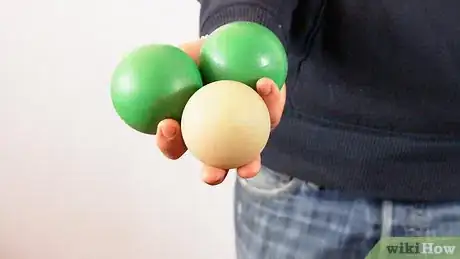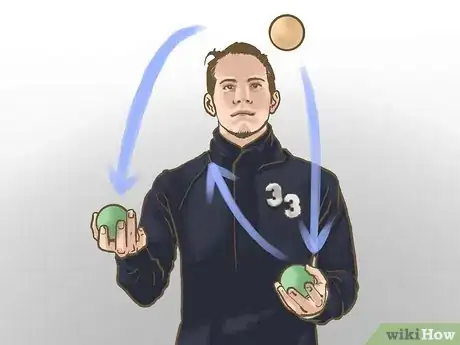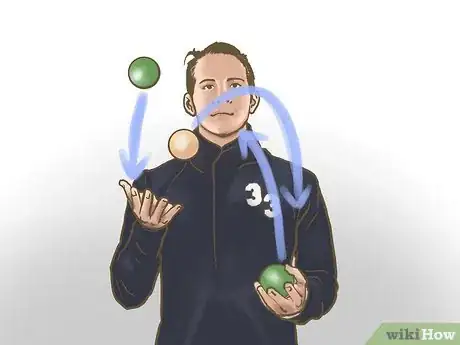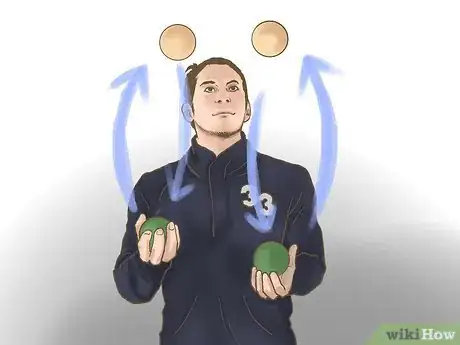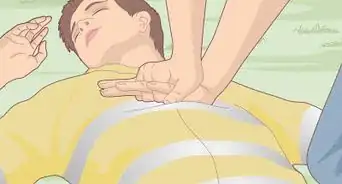wikiHow is a “wiki,” similar to Wikipedia, which means that many of our articles are co-written by multiple authors. To create this article, 115 people, some anonymous, worked to edit and improve it over time.
There are 7 references cited in this article, which can be found at the bottom of the page.
This article has been viewed 1,143,015 times.
Learn more...
Juggling is a challenging but rewarding hobby; studies show that people who learn to juggle increase their brains' grey matter![1] While juggling may seem and be difficult to master at first, it becomes easier once you've learned the basics and practiced it. This article takes you into the basics of three-ball juggling, after which you can begin to introduce more balls.
Steps
Getting the Hang of It
-
1Choose suitable balls. Beanbags are good for beginners. Basically, find balls that will not bounce a lot, or roll away when they're dropped––this will save a fair bit of running initially! A set of beanbags can be bought for a very low price or made by hand. Tennis balls filled with sand or a few pennies and covered with a round balloon also work well. They don't bounce and they provide a slip-free grip.[2]
- While you're at it, choose a suitable place to work in. At the very beginning, balls will end up flying everywhere, so it's best not to stand near granny's precious oil lamp or dad's collection of ceramic cows.
-
2Toss one ball for a while to get the feel of juggling. Start passing one ball from one hand to the other. Also practice "selfies" –– these are throws you catch with the throwing hand. The ball should come to eye-height or higher. Your hands should not move very much, so aim to keep your elbows at your hips.[3]Advertisement
-
3Practice scooping. This is a technique to make juggling smooth. Simply scoop, or dip, your hand before tossing the ball. Keep the dip shallow though; it isn't going to work if you scoop too deeply. Practice scooping and tossing from one hand to another, so that arc does not rise above eye level.[4]
- Simply mimic the movements of jugglers. If you were to "air juggle," do you find yourself moving your hands in small circles? You're already scooping!
-
4Take one ball in each hand. Toss ball A, and when it reaches the top of its arc, toss ball B. Practice until this simple exchange becomes comfortable.[5]
- At the top is key here. This will give you the most time for your next catch. When you start working with 3, 4, and 5, this becomes especially important.
With Three or More Balls
-
1Juggle three balls. Try to make three passes in a row. Start out slowly, simply seeing how the three work together in the air in one rotation. Juggling three is often a matter of understanding the balls' trajectories and how they intertwine. For the majority of the time, one will be in the air while each hand has the other two.[6]
- First hold two balls in right hand and one in left-hand. (Vice versa if you are left handed.)
- Begin with passing from the right hand. (Again, vice versa if you are left-handed.)
- Throw the ball to your left hand and when ball 1 is at the peak, throw ball 2 (the only one in your left hand) under ball 1 to your right hand.
- When ball 2 is at the highest point (at this point, you should also catch ball 1 in the left hand) throw ball 3 under ball 2.
- And when ball 2 is in the right hand just catch ball 3 and this should be it. That's all you do! Repeat away.
- If you can't seem to get the hang of it, work with light, small scarves. They'll give you the time hanging in the air to understand how it all comes together.
-
2Work on the over-the-top method. Now that you've got the simple three-ball cascade down, start juggling "over the top." This is the name for scooping in the opposite direction with one hand. Instead of scooping under and releasing the ball, you catch it, scoop to the outside and throw it over, hence the name.
- You can start by juggling a normal "Three Ball Cascade," and then letting one of the balls do an over-the-top all the time, so that 1/3 of all throws are over-the-top throws. If you make one hand throw over-the-top throws every time, you are juggling a "Slow Shower," and if every throw is an over-the-top-throw, you are juggling a "Reverse Three Ball Cascade." When you have learned this, you can advance onto things like cross hand juggling, columns (one in the middle, two on the sides), and "Mills' Mess."
-
3Move onto four and five balls. Learn to juggle two in one hand, then do two in your left hand and two in your right hand at the same time. For some, juggling four is simpler than three![7]
- Juggling five balls is just like juggling three, but you have to move your hands a lot faster and you need to throw the balls higher. Keep practicing –– it takes time and patience to master.
Community Q&A
-
QuestionCan I juggle easier when standing or sitting?
 Community AnswerIt is much easier to juggle while standing. You have more control of the ball and can be eye level with the peak of the balls once thrown.
Community AnswerIt is much easier to juggle while standing. You have more control of the ball and can be eye level with the peak of the balls once thrown. -
QuestionCan juggling make my mind sharper?
 Community AnswerJuggling makes you more focused, which in turn increases concentration, so in this sense you could say it does help make your mind sharper.
Community AnswerJuggling makes you more focused, which in turn increases concentration, so in this sense you could say it does help make your mind sharper. -
QuestionWhich ball is most suitable?
 Community AnswerThere are balls specifically made for juggling, and they are basically like hacky sacks. These work great because they do not bounce at all or roll all over the place. If you do not have these, other evenly weighted balls work fine, such as tennis balls.
Community AnswerThere are balls specifically made for juggling, and they are basically like hacky sacks. These work great because they do not bounce at all or roll all over the place. If you do not have these, other evenly weighted balls work fine, such as tennis balls.
Warnings
- Juggling is hard and sometimes depressing, sweaty, annoying, repetitive or frustrating or all of these at once. But that is the same for any skill that is worth the time spent mastering it.⧼thumbs_response⧽
- Do not attempt to juggle fire axes. Only professionals know how to do this.⧼thumbs_response⧽
- Avoid juggling heavy objects.⧼thumbs_response⧽
- Juggling is an exercise; try to "warm up" with stretching exercises before a juggling session.⧼thumbs_response⧽
Things You'll Need
- Suitable juggling balls, which you should easily be able to hold two of in one hand. If you don't have juggling balls, you can use anything soft. Handkerchiefs, beanbags, and stuffed balls with the material of a beanbag.
- A bed or couch to practice over (so you don't have to keep bending over).
- Silk handkerchiefs (if desired).
References
- ↑ http://abcnews.go.com/Health/Technology/story?id=116656&page=1#.T7A6k7-XdgI
- ↑ https://lifehacker.com/the-easiest-way-to-learn-how-to-juggle-1797315089
- ↑ https://www.thesprucecrafts.com/learn-how-to-juggle-2266304
- ↑ http://www.jugglingpoet.com/crju/jugthree.html
- ↑ http://www.juggling.org/help/rings/starting.html
- ↑ https://libraryofjuggling.com/Tricks/3balltricks/Cascade.html
- ↑ http://www.jugglingpoet.com/crju/jugfour.html
About This Article
If you want to learn to juggle, practice with beanbags or balls that don’t bounce or roll much when you drop them. Pass a ball from one hand to the other, then toss the ball up to about eye level and catch it with your throwing hand. Drop your hand slightly before you throw the ball, called scooping, to keep the movement smooth. Once you get comfortable tossing one ball, add in another. Alternate tossing each ball when the other is at the top of its arc, which will give you time for a smooth catch. Gradually add more balls, tossing them with alternating hands. If you want to learn how to juggle 3 or more balls at the same time, keep reading the article!
